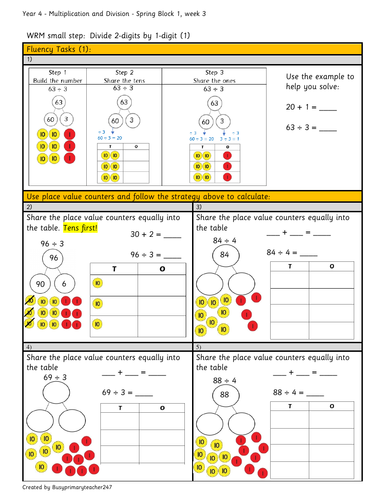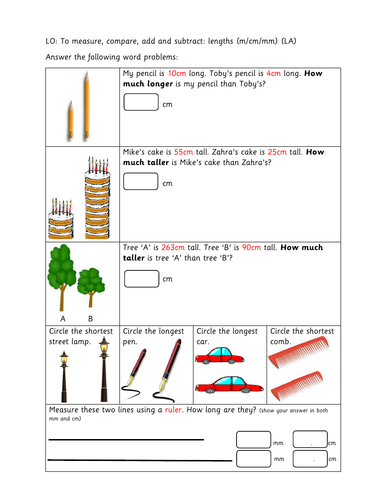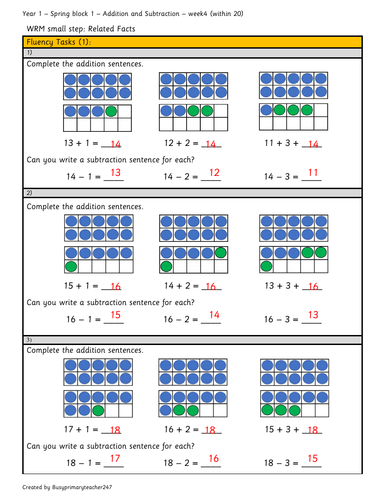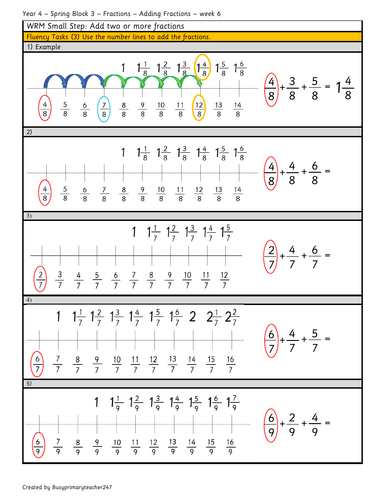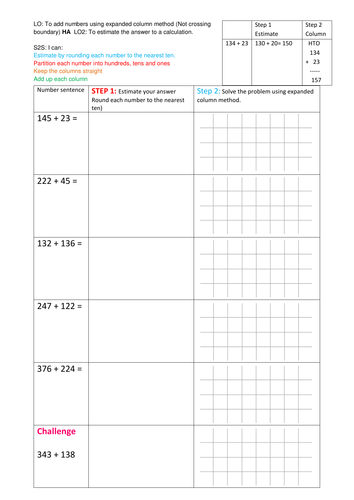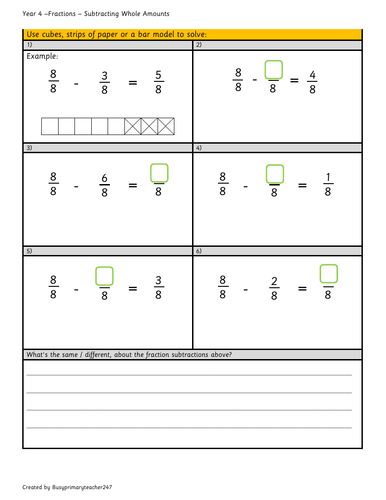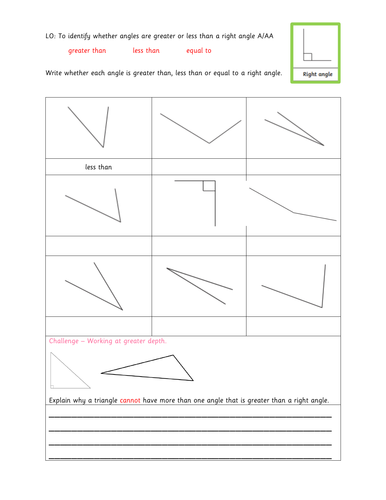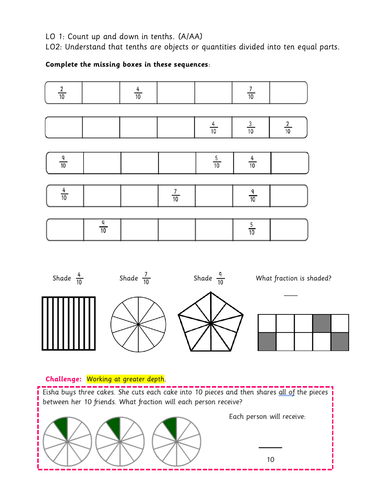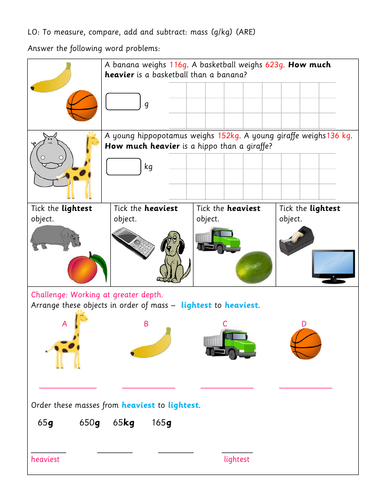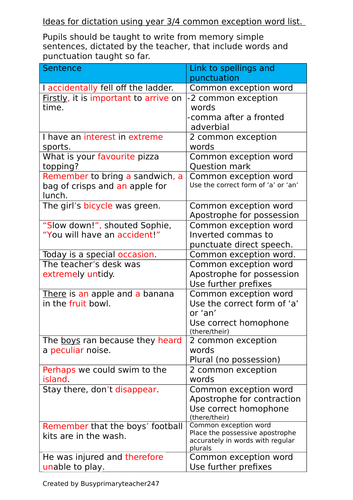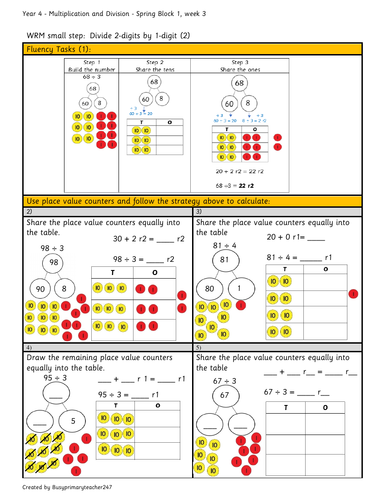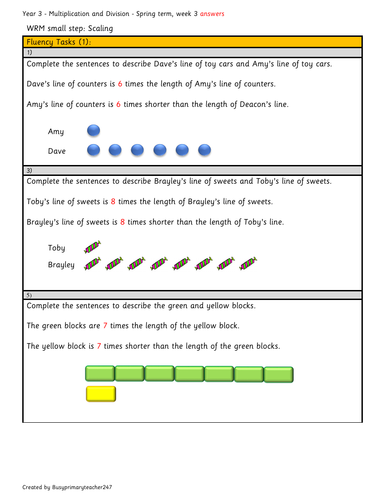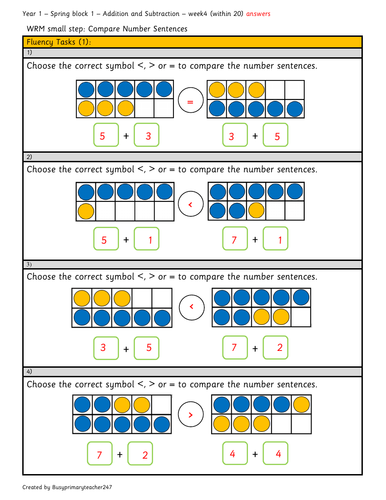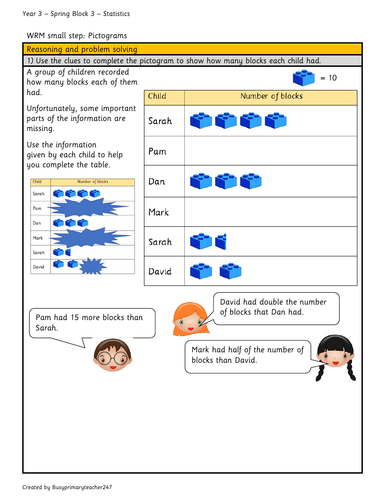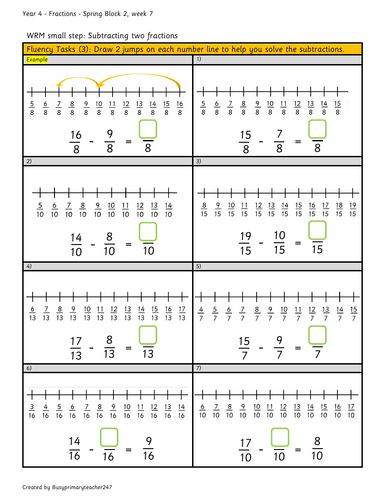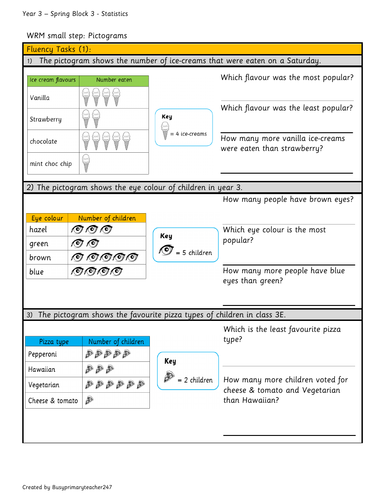132Uploads
180k+Views
66k+Downloads
All resources

Year 4 - Divide 2-digits by 1-digit numbers
This resource links to Year 4, Spring, block 1(week 3) Multiplication, and Division and small step 'Divide 2-digits by 1-digit numbers'
The contents include differentiated worksheets (and answers) that follow the concrete, pictorial and abstract method for maths mastery. They also include reasoning and problem-solving.
Curriculum links:
- Recall and use multiplication and division facts for multiplication tables up to 12 ×12.
- Use place value, known and derived facts to multiply and divide mentally, including multiplying by 0 and 1; dividing by 1; multiplying together three numbers.
- Recognise and use factor pairs and commutativity in mental calculations.
-Solve problems involving multiplying and adding, including using the distributive law to multiply two digit numbers by one digit, integer scaling
problems and harder correspondence problems such as n objects are connected to m objects.
I hope you find these useful,
Your feedback is always welcome x

Year 3 - differentiated worksheets - length
Here are 2 differentiated worksheets based on the length of objects. It includes addition, subtraction, multiplication (integer scaling) and reasoning questions.
Curriculum links:
-Measure, compare, add and subtract: length (mm/cm/m/km)
-Compare the length of objects using mixed units (mm/cm/m/km)
-Compare the length of objects using simple scaling by integers.
I hope you find this resource useful.
Your feedback is always welcome x

Year 1 - Spring block 1 - Addition and Subtraction - Related facts (week 4)
This 11-page resouce follows the concrete-pictorial-abstract approach to Maths Master and also includes answers.
Linked to small step 'Related facts' for week 4, Spring block 1.
Curriculum links:
-Represent and use number bonds and related subtraction facts within 20 -Read, write and interpret mathematical statements involving addition (+), subtraction (-) and equals (=) signs.
-Add and subtract one-digit and two-digit numbers to 20, including zero. -
Solve one-step problems that involve addition and subtraction, using concrete objects and pictorial representations, and missing number problems such as 7= ꙱–9
I hope you find this resource useful,
Your feedback is always welcome :)

Year 4 Count in fractions
This resource links to the WRM Spring block 3 Fractions unit and focuses on adding fractions with the same denominator. As requested, I have included more fluency and reasoning questions.
National curriculum links:
Solve problems involving increasingly harder fractions to calculate quantities, and fractions to divide quantities, including non-unit fractions where the answer is a whole number.
Add and subtract fractions with the same denominator.
Enjoy x

Year 3 - 3-digit by 2-digit column addition with estimating and rounding (No exchanging)
Year 3
3-digit by 2-digit column addition with estimating and rounding (No exchanging) Differentiated worksheets BA, MA, HA
Enjoy! Your feedback is always welcome x

Year 3 - Spring week 1 - Multiplication and Division
This set of resources follows the concrete-pictorial-abstract method of Maths Mastery. It contains fluency, reasoning and problem-solving tasks.
The worksheets are differentiated between lower ability and age-related and the answers are included :)
Links directly to WRM small steps:
- Comparing statements
- Related calculations
- Multiply 2-digits by 1-digit (1)
National curriculum links:
-Recall and use multiplication and division facts for the 3, 4 and 8 multiplication tables.
-Write and calculate mathematical statements for multiplication and division using the multiplication tables they know, including for two-digit numbers times one-digit numbers, using mental and progressing to formal written methods.
-Solve problems, including missing number problems, involving multiplication and division, including positive integer scaling problems and correspondence problems in which n objects are connected to m objectives.
I hope you find these resources helpful!
Your feedback is always welcome x

Place Value - Ordering Numbers Within 50
This resource links with Year 1, Spring Block 2, Number: Place Value (within 50) and uses a concrete - pictorial -abstract method to support the teaching of ordering numbers within 50. It also includes answers.
Curriculum Links
-Count to 50 forwards and backwards, beginning with 0 or 1, or from any number.
-Count, read and write numbers to 50 in numerals.
-Identify and represent numbers using objects and pictorial representations including the number line, and use the language
of: equal to, more than, less than (fewer), most, least.
I hope you find this resource useful x

Year 4 - Subtracting fractions
This resource uses a concrete – pictorial – abstract approach to help children gain fluency and mastery.
Curriculum links:
Solve problems involving increasingly harder fractions to calculate quantities, and fractions to divide quantities, including non-unit fractions where the answer is a whole number.
Add and subtract fractions with the same denominator.
Your feedback is always welcome x

Year 3 - Greater than less than a right angle differentiated assessment
Worksheet / assessment focusing on angles being greater than or less than a right angle. Differentiated into BA and A/AA (Includes greater depth question)
Links to Rising Stars Objectives: Identify angles greater than or less than a right angle.

Year 3 - counting up and down in tenths
Differentiated worksheets based on the National Curriculum and Rising Stars objectives:
- Count up and down in tenths.
- Understand that tenths are objects or quantities divided into ten equal parts.
Includes greater depth question.

Year 3 - differentiated worksheets - Mass
Here are 2 differentiated worksheets based on the weight of objects. It includes addition, subtraction, multiplication (integer scaling) and reasoning questions.
Curriculum links:
-Measure, compare, add and subtract: mass (g/kg)
-Compare the mass of objects using mixed units (g/kg)
-Compare the weight of objects using simple scaling by integers.
I hope you find this resource useful.
Your feedback is always welcome x

20 simple sentences to be dictated to pupils by the teacher - years 3 and 4
This resource contains 20 simple sentences that can be dictated to pupils
( Write from memory simple sentences dictated by the teacher, that include words and punctuation taught so far.)
I have included words from the common exception list as well as some other SPaG items from the year 3 and 4 curriculum.
Curriculum links:
- Write from memory simple sentences dictated by the teacher, that include words and punctuation taught so far.
- Spell further homophones.
- Spell words that are often misspelt (year 3 /4 common exception words).
- Use further prefixes and understand how to add them
- Use further suffixes and understand how to add them
- Use the correct form of ‘a’ or ‘an’
- Use inverted commas to punctuate direct speech
- Place the possessive apostrophe accurately in words with regular plurals e.g. girls’, boys’ and in words with irregular plurals e.g. children’s.
I hope you find this useful.
Your feedback is always welcome x

Year 4 - Spring block 1 - Divide 2-digits by 1-digit (2) week 3
This resource links to Year 4, Spring, block 1(week 3) small step 'Divide 2-digits by 1-digit (2)'
The contents include differentiated worksheets (and answers) that follow the concrete, pictorial and abstract method for maths mastery. They also include reasoning and problem-solving.
Curriculum links:
- Recall and use multiplication and division facts for multiplication tables up to 12 ×12.
- Use place value, known and derived facts to multiply and divide mentally, including multiplying by 0 and 1; dividing by 1; multiplying together three numbers.
- Recognise and use factor pairs and commutativity in mental calculations.
-Solve problems involving multiplying and adding, including using the distributive law to multiply two digit numbers by one digit, integer scaling
problems and harder correspondence problems such as n objects are connected to m objects.
I hope you find these useful,
Your feedback is always welcome x

Year 3 - Spring block 1 - Scaling (week 3)
This set of resources follows the concrete-pictorial-abstract method of WRM and Maths Mastery. It contains fluency, reasoning, and problem-solving tasks linked to WRM small step - Scaling (week 3)
The worksheets are differentiated between lower ability and age-related and the answers are included :)
UK National curriculum links:
-Recall and use multiplication and division facts for the 3, 4 and 8 multiplication tables.
-Write and calculate mathematical statements for multiplication and division using the multiplication tables they know, including for two-digit numbers times one-digit numbers, using mental and progressing to formal written methods.
-Solve problems, including missing number problems, involving multiplication and division, including positive integer scaling problems and correspondence problems in which n objects are connected to m objectives.
Australian Curriculum (V8.3)
-Apply place value to partition, rearrange and regroup numbers to at least 10 000 to assist calculations and solve problems (ACMNA053)
-Recall multiplication facts of two, three, five and ten and related division facts (ACMNA056)
-Represent and solve problems involving multiplication using efficient mental and written strategies and appropriate digital technologies (ACMNA057)
-fluency includes recalling multiplication facts, using familiar metric units to order and compare objects, identifying and describing outcomes of chance experiments, interpreting maps and communicating positions.
-problem-solving includes formulating and modelling authentic situations involving planning methods of data collection and representation, making models of three-dimensional objects and using number properties to continue number patterns
- reasoning includes using generalising from number properties and results of calculations, comparing angles and creating and interpreting variations in the results of data collections and data displays.
I hope you find these resources helpful!
Your feedback is always welcome x

Year 1 - Spring block 1 - compare number sentences (week 4)
This 5-page resource follows the concrete-pictorial-abstract approach to Maths Mastery and also includes reasoning and answers.
Linked to small step 'number sentences' for week 4, Spring block 1.
Curriculum links:
-Represent and use number bonds and related subtraction facts within 20 -Read, write and interpret mathematical statements involving addition (+), subtraction (-) and equals (=) signs.
-Add and subtract one-digit and two-digit numbers to 20, including zero. -
Solve one-step problems that involve addition and subtraction, using concrete objects and pictorial representations, and missing number problems such as 7= ꙱–9
I hope you find this resource useful,
Your feedback is always welcome :)

Year 3 - interpreting pictograms (2)
This resources enables children to read and interpret information from pictograms, make comparisons and ask questions about data. It includes worksheets linked to WRM fluency tasks 1 & 2 and reasoning questions.
WRM Small Step: pictograms
Curriculum links:
-Interpret and present data using bar charts, pictograms and tables.
-Solve one-step and two-step questions [for example, ‘How many more?’ and ‘How many fewer?’ using information presented in scaled bar charts and pictograms and tables.
Enjoy!
Your feedback is always welcome x

Statistics - Bar Charts (edited)
This resource contains varied fluency questions, reasoning and a challenge question. Differentiated 2 ways and includes answers. Linked to Year 3 Spring block 3. Statistics - WRM Small Step - bar charts.
Curriculum links
Interpret and present data using bar charts, pictograms and tables.
Solve one-step and two-step questions [for example, ‘How many more?’ and ‘How many fewer?’] using information presented
in scaled bar charts and pictograms and tables.

Year 3 differentiated worksheet on comparing unit fractions
Year 3 differentiated worksheets on comparing unit fractions. AA includes greater depth reasoning question.
Links to Rising Star's objective: Compares simple unit fractions.

Subtracting two fractions (3) using a number line
This resource supports Year 4 WRM small step ‘Subtracting two fractions’, and focuses on using a number line for varied fluency 3 questions. It follows a concrete – pictorial – abstract approach.
It includes differentiated worksheets and answers.
Curriculum links
• Solve problems involving increasingly harder fractions to calculate quantities, and fractions to divide quantities, including non-unit fractions where the answer is a whole number.
• Add and subtract fractions with the same denominator.
I hope you find this resource useful x

Year 3 - interpreting pictograms (1)
This resources enables children to read and interpret information from pictograms, make comparisons and ask questions about data.
WRM Small Step: pictograms
Curriculum links:
-Interpret and present data using bar charts, pictograms and tables.
-Solve one-step and two-step questions [for example, ‘How many more?’ and ‘How many fewer?’ using information presented in scaled bar charts and pictograms and tables.
Enjoy!
Your feedback is always welcome x
Edited
Error on Q4 has been corrected.

